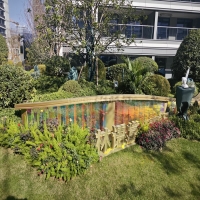Welcome to the website for landscape facilities products and knowledge.
What are the environmental impacts of manufacturing concrete-based landscape tables?
Concrete-based landscape tables are popular for their durability and modern aesthetic, but their manufacturing process carries significant environmental consequences. The production of concrete contributes to approximately 8% of global CO2 emissions, primarily due to cement production, which requires high-temperature kilns and releases large amounts of carbon dioxide. Mining raw materials like limestone and sand also disrupts ecosystems and depletes natural resources.
Additionally, concrete tables are heavy, increasing transportation-related emissions. Water usage during mixing and curing further strains local supplies, while waste from imperfect casts often ends up in landfills. However, some manufacturers are adopting greener practices, such as using recycled aggregates, low-carbon cement blends, or carbon capture technologies.
For eco-conscious consumers, alternatives like reclaimed wood, recycled plastic, or bio-composite materials may offer lower environmental footprints. When concrete is preferred, opting for locally sourced materials and minimalist designs can help reduce the overall impact. Proper maintenance also extends product lifespan, offsetting some of the initial environmental costs.
As sustainability becomes a priority in outdoor furniture design, weighing concrete's longevity against its ecological toll is essential for responsible purchasing decisions. Innovations in material science may soon provide more planet-friendly versions of this versatile landscape staple.
Related search:

Recommendation
Metal and acrylic color-changing combined curtain wall for large-scale public landscape facilities